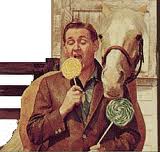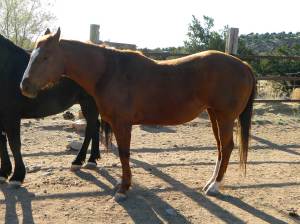 “A horse is a horse, of course, of course…,” Mr. Ed sang for his theme song, but did he fit the average horse mold? Not on your life!
“A horse is a horse, of course, of course…,” Mr. Ed sang for his theme song, but did he fit the average horse mold? Not on your life!
Horses have as diverse personalities as we humans do, and being able to identify them can really help you find your horse-match made in Heaven. One ingenious personality typing system, devised by equine veterinarian, Dr. Madalyn Ward, can be studied in her book, Horse Harmony – Understanding Horse Types & Temperaments. And you can test your horse (and yourself) for free on her site in order to see if the two of you are a good match. Dr. Ward’s system is based on ancient Traditional Chinese Medicine, which breaks down constitutional types into 11 different groups, each of which is unique in terms of what kind of nutrition, activity, training/learning methods, etc. suit it best.
Intrigued? Here are a few quick clues on identifying the personality type that best fits your horse. These are excerpted from Dr. Ward’s most recent newsletter, with permission. If you like what you see here, visit the site, take the test, and, better yet, buy the book to read about your horse’s type in depth.
Horse Temperament: 11 Quirks for 11 TypesWe list 11 quirks below, one associated with each horse temperament type. Scan through the list and see if any of these quirks rings a bell. This will help you determine your horse’s temperament type, especially if you are straddling the fence between two types!Fire: Often rolls the tongue or flaps the lips, especially when younger or under stress.Earth: When happy, often gives a contented sigh and carries an air of calm and peace.Water: When balanced, has the keen look of the eagle and is one of the most regal-looking types.Metal: Thrilled to do his job as soon as he learns it. Does a trademark grimace with his mouth when he can’t figure out his job.Wood: Loves to break things. If every gate, post, and horse toy on your place is busted or bent, you’re horse is a Wood!Shao Yang (Fire/Wood): Dislikes being touched, especially on the feet or toward the hind end.Jue Yin (Wood/Fire): Causes trouble in a playful way … loves to mess with you!Tai Yang (Water/Fire): Exuberant and loves to move … the happier he is, the faster he moves, ears pricked and exuberant! Why walk when you can trot? Why trot when you can canter?Shao Yin (Fire/Water): The most affectionate type, likely to nudge you, loving, innocent.Yang Ming (Metal/Earth): Willing to please, not very spontaneous (will give lots of warning before bucking or shying or causing trouble).Tai Yin (Earth/Metal): Very dedicated to one person, to the point of happily doing just about anything for the person they love, even if the task is difficult. Will perform for others, but not eagerly.Horse Temperament: Quirks Ring a Bell?Hopefully the above list of quirks will help you more easily determine your horse’s temperament type. Sometimes it’s the little things that our horses do that make them stand out as one horse temperament type or another.

